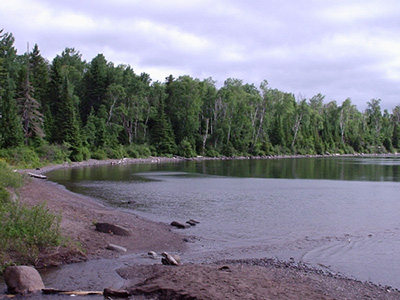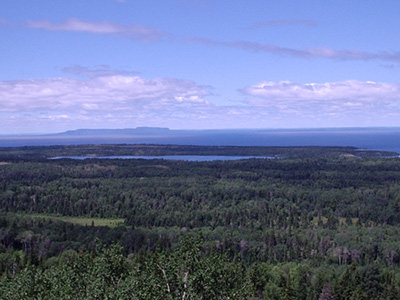Do you think of yourself as a Midwesterner? A Northerner? If you live in Chicago, author Ted McClelland would call you a Great Laker. McClelland spent last summer driving around the Great Lakes — a 9,600-mile trip that took him as far west as Duluth, Minnesota, and as far east as Kingston, Ontario — to research his upcoming book, The Third Coast, which looks at the Lakes as a distinct region of North America, with its own culture and common interests. Gapers Block is pleased to present a series of excerpts from the book over the next several months.
Isle Royale, Michigan
Isle Royale is a long way from a long way from anywhere. It's the least-visited National Park in the Lower 48 — about 15,000 people come here every year — and one of the remotest spots on the map, period. Once you set foot on Isle Royale, your car is 55 miles behind you. I went there last summer with this goal in mind: to see one of the moose who live there as prey to the island's wolfpack.
To catch the once-a-day ferry to this island in the northwest-corner of Lake Superior, you have to drive to Copper Harbor, at the tip of Upper Michigan's Keweenaw Peninsula, a barely-inhabited land of fir, spruce and billion-year-old rock.
Once you cross the ship canal from Houghton to Hancock, it's a long steep haul past Coppertown, U.S.A., an abandoned mine pit south of Calumet, and past the Jampot, where monks make jelly out of thimbleberry, a boreal shrub that thrives in cool Northern woods.
For dramatic coastlines, Big Sur is the champion of the West, Maine of the East, and Keweenaw of the Great Lakes. A two-lane state highway threads the ledge between the forested hills and the frenzied beach, where the tide slaps over copper-tinged boulders, forcing surges of froth through the gaps. If you didn't know you were in Michigan, you'd expect to hear seals.
In the winter, Copper Harbor is a cross-country ski resort — exposed to every nor'wester that blows across the Big Lake, it has gathered 390 inches of snow in one winter. Copper Harbor is also the end of the road for U.S. 41, which was a snowbird migration route in the pre-interstate '30s and '40s. There's still a mileage sign in the middle of town: MIAMI FL 1990. The Isle Royale Queen IV, an ex-New York City ferry called out of retirement, leaves every morning on a three-hour voyage to the island. The Queen IV recently replaced a smaller, slower vessel nicknamed "The Barf Barge," thus saving an hour — and innumerable breakfasts.
On a late-June morning, the Queen set out under black-powder clouds. It wasn't long before the Keweenaw revolved over the horizon, and the boat was churning through a compass of water, ringed by mist. It was like sailing on a watery planet. You couldn't judge the distance to the horizon. The boat might have been floating in a 100-foot water tank, or adrift in the North Atlantic.
The landing, at Rock Harbor, is the only developed corner of Isle Royale. One percent of the island is set aside for a camper's commissary, a gift shop, and a lodge with soft beds. The rest is a wilderness of forests, meadows, rocky ridges and inland lakes.

Isle Royale was not always so isolated from civilization: the Ojibway canoed here to chip copper from a 2,000-pound boulder, and the woods are pitted with abandoned 19th Century mines. Norwegian fishermen from Minnesota wintered over in cabins, and hay fever sufferers cottaged here before anti-histamines made ragweed less of a misery. When the Park Service took over in 1940, it granted life leases to landowners. The shrewdest wrote down the names of their youngest grandchildren, so there are still a half-dozen cabins, and one family with fishing rights. After the park closes each November 1, the only visitors are wildlife biologists who fly in to count the moose and the wolves. Long ago, coyotes and caribou played the predator-prey game here, but then moose swam over from Canada, and wolves walked across an ice bridge in the winter of 1948. Moose sightings are common on Isle Royale — moose have no sweat glands, so when the temperature hits 50, they're neck-deep in water. But only one hiker in a thousand ever sees a wolf.
I only had three days on the island, so a wolf sighting seemed out of the question. A moose seemed within reason, though. I began walking west, in the direction of Windigo, the ranger station at the western tip. That's a five-day hike. I hoped only to get as far as Daisy Farm, the second campsite on the trail. It was seven miles away, and I still had a long early-summer evening.
Isle Royale is the essence of the North reduced to 133,000 acres. I worked Trees and Wildflowers of the Great Lakes from my overstuffed backpack and began searching for plants that had been choked out of less insular country. I saw thimbleberry, its tiny pods not yet budded to fruit; wild rose; wood lily; ox-eye daisy; and every time I looked up from the trail, the spindly profile of a spruce.
I got lost on the way to Daisy Farm, so I spent a rainy night at Three-Mile Camp, where I found an empty sleeping shelter. The shelters were screened-in porches, without the house: plank floor, sloping roof, concrete-block pillars. I set up my tent inside, because this was the coldest June 30 I had ever experienced: the temperature dropped to 45 degrees, and I had to slip directly from my jacket to my sleeping bag to keep warm.
I finally made it to Daisy Farm the next morning, slipping over mud, roots and rocks every step of the four-mile hike. I sat down on a bench overlooking Moskey Basin and opened a can of sardines. A flock of loons paddled in the cove. Across the still water, at the mouth of the inlet, I saw Rock Harbor Lighthouse and a ruined fishing shack. It was only 11 o'clock, so I decided to hike up to the Greenstone Ridge, the backbone of Isle Royale, and then on to the scenic overlook at Mount Franklin.
Mount Franklin is named for Ben, who brought Isle Royale into the United States during the negotiations that ended the Revolutionary War. One story says that 18th Century maps misplaced the island in the middle of the lake. More flattering to Franklin's shrewdness is a version that insists he knew there was copper here.
On this high-definition afternoon, the peak of Mount Franklin offered a brilliant, wide-screen view. To the south, I saw meadows of summer-faded grass, flecked with yarrow and thistle. To the north, past a jungle of evergreens and miles of gloomy water, was Ontario's Sleeping Giant, a range of hills shaped like a reclining man.

I did not see a moose, though, nor did I see one on the walk back to Rock Harbor. I only saw cairns of moose droppings, which I'd learned to recognize from Upper Peninsula party stores that sold chocolate candies in their shape.
When I got back to Rock Harbor, I met a mother and three girls outside the commissary. Their hair was lank, their faces were sheened with sweat and grease, and they smelled like tramps. They'd been on the trail four days. I asked them if they'd seen a moose.
"We did see a moose," the mother said. "It was acting bizarre. It just kept charging through the lake, like it was running at something. Maybe it was trying to get the flies off itself."
I asked the same question of a park ranger I met that night.
"I don't know where all the moose went," she said. "There was one right in front of the auditorium on Tuesday. It was standing right on the path."
My last morning on the island, I canvassed the coves on the eastern end, but I boarded the Queen without having seen a moose.
Back in Copper Harbor, the Queen's owner, Don Kilpela, was in his office, sporting a Rotary Club polo shirt. He'd just finished scooping ice cream at the Pasty Fest in Calumet.
"One thing about Isle Royale," he told me. "They say it's the least-visited National Park, but the most re-visited. Thirty percent come back. I have people on that boat who've gone every year I've owned the boat. If I knew what it was, I'd sell it."
Maybe they're still trying to see a moose.
Read on:
1. Sheboygan & Manitowoc County, Wisconsin
2. Marquette, Michigan
3. Mackinac Island, Michigan
4. Grand Marais, Minnesota
5. Pays Plat First Nations Reserve, Ontario, Canada
6. Isle Royale, Michigan
7. Rogers City, Michigan
8. Toronto, Canada
9. Hamilton, Ontario
10. Hamburg, New York
Buy the book.





